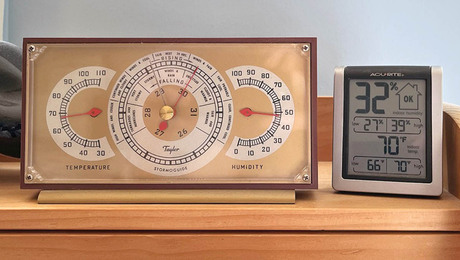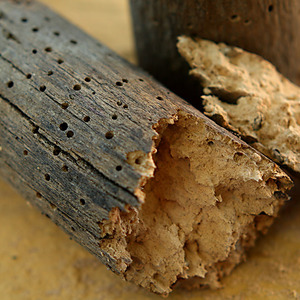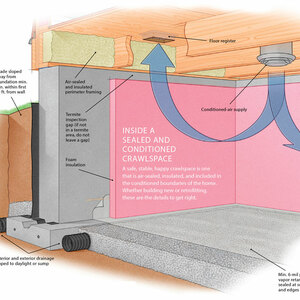*
what if someone decided to put in a subfloor of two layers of 3/4″ ply,
and then had an industrial router and made grooves to accept PEX tubing for radiant floor heating, what would you guy’s think of this? is there any holes in my theory?
any suggestion’s?


















Replies
*
Sure it would work. Suggestions:
Make a template or guide to router out radiuses of at least 1 foot. 2 feet is better.
Recorded on graph paper where all the grooves/tubing are. Very helpful if you have to nail something down in the future.
Consider what part of the floor you want to be warmest and run the tubing there first. The water coming back is not as hot as the water coming back
270-280 foot are easiest to utilize the 300-foot rolls of PEX (leaving some out to connect to). But 125-130 foot loops are a bit more responsive and have a lower pressure drop. However, they do require a bigger manifold. -David
*if i put ordinary fibreglass insulation under the sub-floor, would this be enough to reflect the heat up?would i just lay the flooring diretly over this, whatever it was, how?what do ya think?
*Insulation does not reflect heat at all. It only resists the transfer of heat to other surfaces. Some foils claim an ability to reflect heat if they're surrounded by an air space. I don't vouch for their claims one way or the other (i.e., I dunno). The true "Warmboard" also includes a layer of aluminum or some such to spread the heat more evenly, I believe.
*Easier than routing channels might be to put down sleepers, run the PEX, then add the second layer of subfloor. FG under the floor works fine in my house. I used Miraflex because it was the cheapest stuff I could get and coincidentally, is encapsulated entirely in plastic. Even so, the fibers at the cut ends were nasty. The majority of the heat will travel in the easiest direction, so I think that even a low r-value insulation will make a difference.Andy
*ITA. It absolutely makes a difference in a path of least resistance kind of way. Wherever your heat source is in the floor, you want less resistance above it than below it. I was getting literal on something I've heard from many people over the years--the mistaken belief that insulation bounces heat back into a room, rather than just slows its transfer to a colder space.
*The key to warmboard is not the grooved channels, but the aluminum plates. These plates allow more surface area to contact the tubing, increasing the amount of heat transmitted to the flooring. Similar to fins on an air cooled engine. A foil backed insulation placed a couple inches beneath the floor seems to be the best.
*Chris L2 is right. The aluminum surface, which is molded down into the grooves, is the main reason for Warmboard's high rate of thermal conductivity. Also, because it is bonded permanently to the subfloor material, it eliminates any side-to-side expansion and contraction.The post by Cloud Hidden is also correct with regard to insulation. Heat is transferred by three main methods:1) Conduction (passed along solid materials)2) Radiation (broadcast in a straight line like light)3) Convection (heated molecules expand and get lighter, then rise)The only type of heat effected by reflective material is radiation. If the reflective material is dulled (by dirt, dust, other materials), the reflectivity is compromised. That is why the manufacturers of bubble-foil insulation always qualify their R-values by saying that an air space is needed for them to get such high marks. It also stands to reason that as time passes, reflective surfaces will eventually get dull from settling dust and gradually lose their effectiveness. (Any thoughts from the insulation community?)When dealing with conduction, heat is lazy and will follow the path of "least resistance." So the simple formula is to provide MORE resistance (R-value) in all the directions you DON'T want the heat to go. If you have a carpet, pad, subfloor assembly where R=X, then a good rule of thumb that I have heard from the heating guys is you need X times 2 or X times 3 under the heat source to insure the heat goes in the right direction. The insulation must have CONDUCTIVE R-value greater than the conductive R-value of the stuff on top. The less dense the material, the greater the R-value. Air is a great insulator, so most insulation products are full of it.Interestingly enough, it also makes sense to put the heat generation up as close to the objects of your heat (the customer) as possible so you have fewer layers of resistance to go through. You lose efficiency with each layer. Another of Warmboard's strengths is that it captures the CONDUCTED heat from the tube very well right at the surface of the floor, conducts some more only through the floor coverings, which then RADIATES into the room and heats the customer even before the air has come up to temp. You can't get closer to the customer than that without making Warmboard your finished floor. It may be a great product, but my wife would have a problem with Warmboard as a finished floor.It would be difficult to duplicate Warmboard without violating the patent! However, the simple laws of thermodynamics would suggest that you conduct the heat to as close as possible to the object of your heat by creating resistance where you DON'T want it to go, then radiate it into the room with as much surface area as possible so you can use lower temperatures and provide comfort in every area they reside.Barry LaDukeWarmboard Regional Sales ManagerPacific [email protected]
*More insulation below the tubing than above is important for control reasons rather than heating efficiency. If all the heat is inside the building envelope, then none is wasted. But if you heat hte upstairs when the downstairs is warm enough and there is no insulation between them, then temps will go too high downstairs.Barry: "violating the patent!"? You going to hunt down a homeowner for using his router on the subflooring? Maybe get John Ashcroft to make a federal case out of it?I don't think he is planning to market the stuff. And Ashcroft is pretty busy just now with all that wire tapping and setting up those military tribunals.
*David,If this is a ground-level floor, then w/o insulation would heat leave the building envelop? I _do_ remember my HVAC guy telling me what you describe as pertaining to both of my elevated slabs. I'm guessing that a ground-level or over-crawl-space floor needs both control and efficiency. Or is that technically still all control reasons?On the "patent" stuff, I was hoping that was Barry's corporate humor. Right? Right?
*Cloud: Definitely insulate the heck out of the ground floor if it is a slab or especially if a crawl space. I've got 2" of blueboard (R-10) under and around my radiant slab. FG batting between the floor joists would be great for fighting conduction to the crawl space. Some kind of vapor barrier would cut the infiltration a lot.As I often post, an inch or two of spray urethane really tightens up the house. Then fill the rest of the bay with cheap FG batting. Might be hard to stuff the urethane guy in his moonsuit into the crawlspace, though. -David
*>an inch or two of spray urethane really tightens up the houseHey, we used 8 sets of it!!! You're preaching to the choir. Jim
*Hey guys, I'd like to point out that Barry LaDuke's comments are exactly the type of post I like to see from a manufacturer's rep. He address specific questions about a product, and he tells you what his point of view is in an informational manner.Barry, I have a question for you. You say that "You lose efficiency with each layer. " Does this mean that the heat transfer is slowed down? Clearly, the heat has to go somewhere, so it's not being lost (except perhaps some slight amount sneaking out where the floor meets the wall).Andy
*INFORMATIONAL???????????????you do good english have
*Yes, it was a feeble attempt at humor. I guess I'm not good at stand up (or sit down) humor, so I'll keep my day job.Thank you for the nice compliment, Andy. Good job on Craig Hudson's piece, by the way. Any way to get prints?Barry
*I've always used the "3-times" rules...three times as much R-value below the RFH tubing as there is above the tubing.If the tubing is not in a slab...either stapled up on the bottom of the subfloor or stapled/secured between sleepers on top of the subfloor, I use the following: Half-inch foil-faced polyiso RFBI, friction-fit between the joists and tucked up as high as it will go...either against the staples for a staple-up, or up against the bottom of the subfloor for a sleeper set-up. Under that, always R-19 FG batts in the basement ceiling for the first floor, and either R-19 or R-11 for the other assemblies inside the building envelope. The FG provides marginal sound attenuation in the floor assemblies as well. Marginal.I agree, to a certain degree (no pun intended), that as long as the heat stays in the conditioned envelope it's a "good thing"...but helping direct the heat "up" to the room you intend it to go to helps balance the whole-house temp and prevents overloading one room with warmth while starving another.Theoretically, and very basically (yeah, myriad variables), a floor assembly with 3/4" T&G strip hardwood flooring over PEX and sleepers on top of the subfloor will put more heat into the room than a staple-up with 3/4" subfloor, half-inch underlayment, a 3/4" hardwood strip floor, and an oriental rug with pad sitting on top of it.Though arguments can be made, to a certain extent heat will take the least restrictive (lowest R-value) path. You don't want your first floor's RFH to be heating your basement, nor do you want your second floor's heat going to the first floor, resulting in cold bedrooms above.Andy, if I recall, you have RFH and cells for insulation. What kind of RFH did you install? Did you install central AC as well? Just curious.Been a beautiful autumn here in CT, eh?Regards, Mongo
*Mongo, I installed 1/2-in. PEX stapled up with Stadler aluminum plates. Not sure I'd bother with the plates next time. Weissman boiler w/ sidearm DHW. No AC. I oriented the house east-west, rammed the windows up within 3-in. of the ceiling to maximize the shading from the 2-ft. roof overhang on the second floor and a 12-ft deep porch on the south side first floor. Deciduous trees to the west. After about 9 or 10 AM, there's no direct sun coming into the house at the summer solstice. U-.31 low-e windows, which we open at night and close in the morning. Between these features and the cellulose, we wanted for AC maybe 2 weeks last summer. This time of the year, we get sun that reaches all the way to the north wall of the house. It's been a great fall. Of course, I spent the coldest night so far, the Saturday before Veterns Day, camping with my son's Scout troop. I can't wait for the January trip.Andy
*It sounds like a well thought-out plan regarding solar. Nice job. I didn't do as nice a job regarding design with my house, didn't know enough at the time. Even with a couple of nice oak trees to shade, we do heat up in the summer, so we just put in AC this past July. I really wish I had known about cellulose back then, I think that would have been beneficial re: heat gain compared to FG. A side benefit of the AC is with all the wood I have in the house, the humidity control helps minimize wood movement. Plus, it doesn't take me 45 minutes to dry after taking a shower.I did staple-up RFH in my house, too...5/8th PEX for the first floor, half-inch for the second. No plates. I have 3/4 TG subfloor, half-inch ply underlay, then brazilian cherry over that. I love the RFH.After about several weeks of gorgeous late-summer and early fall, I had the Cubbies over my house for a camp out at the fire circle/camp area we made in the woods behind my house. It rained. Of course, there was no rain for the two weeks after the campout.I've got the girl scouts camping out in about two weeks. I'm forecasting frozen sleet.Regards, Mongo
*Overhangs seem to be the most useful and least used feature on houses for controlling energy usage. It's a pet peeve. A neighbor just built a house on the side of a hill with no tree cover, a true south exposure, and maybe 4" overhangs. The windows get beat on all day every day. What a waste. Sun charts are easy to find and easy to follow.Andy, why not alum plates if do-over? Can't the difference be felt? Do you get the "striping" Barry mentions or is the heat evenly spread? Warmboard has alum layer--would this act similar to or different from plates?Cheers,Jim
*My plates are under 3/4-in. T&G underlayment and 3/4-in. oak, for the most part. The tiled areas aren't yet, just another 1/2 in. of plywood covered with cheap vinyl in the kitchen and bath. So, yes, there is some striping, but I still love the rfh. The plates were pricey. I suspect that if I'd suspended the PEX on plastic plumber's strap and nailed up some foil-faced polyisocyanurate, the net effect would have been similar and my neck wouldn't have been so stiff from stapling plates overhead.Amen to the overhangs, and to paying at least some attention to solar orientation. We've got a new house going on the lot in front of us, which we refer to as the Taj Ma Neighbor. Nice, low hilltop lot, which my wife and I fantasized would be perfect for a classic Greek Revival. Imagine the gable facing the street, which would have given the south wall a perfect exposure. Nope. A megalonial with every roofline ever invented and a blank wall facing south. Ah well. Andy
*mongo, thanks for the post!we do not have some of the insulating materials that you lot have across the pond, but if i could find the half-inch polyiso with the foil coating, which side up?and what do you use to secure the PEX to the sub-floor (from above using sleepers method)thanks again
*I put 18" overhangs on my house.When I was wrestling the overhang ladders up over the top of the gable walls, a couple of guys on the crew that were working on the house next door came over to take a gander. I think they may have just been waiting to see the stupid oaf up on the roof take a 30' plunge.Anyhow, their comment? "Overhangs aren't worth the epense or the effort."Heck, they're great for solar, great for shielding the windows and siding from rain, and just plain old great from an aesthetic viewpoint.The back of my house, which faces the lake, is about 15 degrees west of south...about 195 degrees mag. I put an approximately 1300 sq foot bluestone patio at the back of the house, and that is one heck of a radiant machine in the summer. It was designed to have a pergola shading about 55% of the patio, as well as shading many of the windows on the south wall from the summer sun...but you got it...that's a project for another day. Something like #83 on the list of 306 things still to do.
*Eddie, Glad to have helped. The foil-faced that we have here has foil on both sides.If your polyiso comes with the foil on only one side, place it so the foil faces the PEX. You want the foil to act as a radiant barrier, reflecting the heat back up to your floor and into the room that you are trying to heat.Most tubing manufacturers/suppliers also sell proprietary staples and a special staple gun to staple the tubing to the floor. I did see one staple up where a DIYer used Briscon cable staples.I'll see if I can find a RFH accessories (staplers, staples, tubing cutters, etc) link for you...Here is a hit page from Google...lots of links...from pneumatic staplers costing big bucks to manual staplers costing $40USD. I gave a quick look, seaching for a "uk" tag to speed up delivery, but didn't see any on the first page. some of those links are doing a hard sell to move product, so look around before you start throwing your cyber-pounds around.
*thanks mongo,i just found out today that the companies in ireland that supply the PEX tubing will only do it on a 'buy all or nothing' procedure. that way the get a lot more money, they won't even give me a price for the PEX by the roll.thanks again
*
what if someone decided to put in a subfloor of two layers of 3/4" ply,
and then had an industrial router and made grooves to accept PEX tubing for radiant floor heating, what would you guy's think of this? is there any holes in my theory?
any suggestion's?